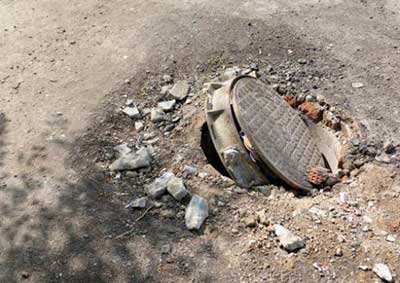Relevance: GS-2: Devolution of Powers and Finances up to Local Levels and Associated Challenges
Key Phrases: Article 243Q, 74th Constitutional Amendment Act of 1992, MoHUA, Popular politics, User charges, Property Tax, SDG 12
Why in News ?
- Urban Local Bodies (ULB) play an important role in ensuring that Grass root democracy becomes substantive.
- Despite the constitutional backing with the 74th Constitutional Amendment Act of 1992, they have struggled to become a self-sustaining and a financially viable body.
Urban Local Bodies
- 3 types
- Municipal Corporation - for more populous cities
- Municipal Council
- Nagar Panchayat
- Direct elections for the members of municipality
- State Assembly to decide for the manner in which chairperson of municipality will be selected
- The State Legislature may by law:
- Authorise a municipality to collect, collect and appropriate taxes, duties, tolls and fees.
- Allocate the taxes, duties, tolls and taxes collected and collected by the state government to a municipality.
- Granting of aid to municipalities from the Consolidated Fund of the State.
- Establishment of funds for the credit of all municipal funds.
Key Highlights
- ULBs have failed to initiate financial reforms in order to
invest in infrastructure creation and maintenance.
- They have remained dependent on easily gained grants from Union and State governments.
- Their own sources of revenue are severely limited. These include
- Property tax,
- User charges,
- Rentals from municipal properties in the form of rent from shops and hoardings, parking charges, etc.
Steps taken
- The Centre has been encouraging ULBs to do the credit rating and
issue municipal bonds, and also implement reforms in user charge
collection apart from property tax collection.
- Ministry of Housing and Urban Affairs (MoHUA) data presented to the Lok Sabha this month shows that not many ULBs have responded to the Centre’s encouragement to go for credit rating, municipal bonds and property tax reforms.
Data Corner (as per data by MoHUA)
- 10 cities have issued municipal bonds
- ₹13 crore have been earmarked as incentive for issuing of bonds worth ₹100 crore, subject to a maximum incentive of ₹26 crore per city
- 470 cities have completed their credit rating and 164 cities have got investment-grade ratings

- Atmanirbhar Bharat Abhiyaan,
- The Centre has allowed States an additional borrowing for 2020-21 of 2% of Gross State Domestic Product (GSDP).
- About 0.25 % of this additional borrowing was linked to reforms
in property tax and user charges for water, sewerage and drainage.
- Accordingly, only 11 States have undertaken these reforms and qualified for 0.25 per cent additional borrowing.
Property tax and popular politics
- As per 15th Finance Commission grants for ULBs for the year 2022-23,
States are mandated
- To notify floor rates of property tax, and
- For the following years, demonstrate increase in property tax collections equivalent to the simple average growth rate of the State’s own GSDP in the most recent five years.
- Atal Mission for Rejuvenation and Urban Transformation (AMRUT) 2.0
and Swachh Bharat Mission (SBM) (Urban) 2.0 launched in October
2021 mandate property tax and user charges reforms.
- About 500 AMRUT cities where water supply coverage has improved substantially, are mandated to submit a roadmap for achieving 90 per cent billing and collection.
Urban sprawls
- Current Status:
- There are approximately 4,800 cities and towns in India, with around 40 crore inhabitants.
- At the current rate of growth, urban population in India is estimated to reach 60 crore by 2030.
- It is projected that more than 50 per cent of the country’s population will be urban by 2050.
- However, cities and towns are still struggling to put basic
infrastructure in place. This is visible in schemes executed by the Centre.
like
- Atal Mission for Rejuvenation and Urban Transformation 2.0 (AMRUT 2.0),
- Smart Cities Mission,
- Swachh Bharat Mission-Urban 2.0 (SBM-U 2.0), and
- Pradhan Mantri Awas Yojana Urban (PMAY-U)
- The ULBs have utilised funds under these schemes to set up and strengthen the crumbling infrastructure.
Challenges
- Popular politics played by local leaders of ULBs renders any tax
reforms null and void.
- They don’t increase property tax and user charges
- Elected bodies are unwilling to approve the proposals by the municipal
administration in case of proposition of a hike in property taxes and
user charges.
- As they don’t want to become unpopular in the eyes of their constituents.
- Sense of belongingness is also decreased when the public goods are seen to be exploited by Free riders.
- Cities selected for Smart City Mission are busy using the funds to fix the problems like water supply, sewage, and transport which are basic needs of any city. AMRUT is also focused on these basic needs.
Conclusion
- Sustainable Development Goal 11 makes it imperative on the developmental bodies to “Make cities and human settlements inclusive, safe, resilient and sustainable”. In order to achieve this target financial independence, property tax reforms and necessary political will are required.
Source: The Hindu BL
Mains Question:
Q. Mention the status and challenges faced by Urban Local Bodies in achieving financial independence? Also suggest a suitable way forward.









